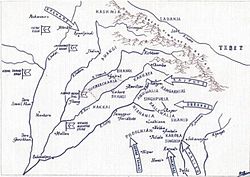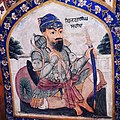| Misls of the Sikh Confederacy |
|---|
 |
The Shaheedan Misl, [1] also known as the Shahid Misl [2] or Nihang Misl [3] , was one of twelve Sikh Misls that later became the Sikh Empire. It held a small amount of territory in the Malwa (Punjab) area around the Damdama Sahib [4] before being incorporated into the Sikh Empire of the Sukerchakia Misl by Ranjit Singh.
Contents
Deep Singh (later Baba Deep Singh), son of Bhagta, of village Pahuwind (now district Amritsar) was the founder of this Misl. Earlier this Misl was known as Deep Singh’s Misl but after the martyrdom of Deep Singh in 1757 and another Sikh general Gurbakhsh Singh (of Leel village) in 1764, this Misl came to be known as Shaheedan Misl.
The Shaheedan Misl was more akin to a religious-order rather than resembling a large, family clan like most of the other misls of the Sikh Confederacy. [5]



